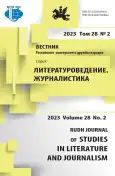Европейское телевидение 2020-х гг.: проблемы и тенденции развития
- Авторы: Ершов Ю.М.1
-
Учреждения:
- Филиал Московского государственного университета в г. Севастополе
- Выпуск: Том 28, № 2 (2023)
- Страницы: 293-305
- Раздел: Журналистика
- URL: https://journal-vniispk.ru/2312-9220/article/view/318905
- DOI: https://doi.org/10.22363/2312-9220-2023-28-2-293-305
- EDN: https://elibrary.ru/OTFZVW
- ID: 318905
Цитировать
Полный текст
Аннотация
В центре внимания автора институциональное своеобразие телевидения стран Европейского союза. Цель исследования - объяснить характер института европейского телевещания, который лучше, чем что-либо еще, отражает идею общеевропейского дома. Дается краткий исторический обзор создания Европейского вещательного союза и сотрудничества между национальными вещателями в Европе. Ставится задача выявления динамики и тенденций развития содружества европейских вещательных компаний в контексте политических, экономических и технологических изменений последних лет. Европейское телевидение - это полигон глобального ТВ, в котором все большую роль играют международные (прежде всего, американские) и панъевропейские трансграничные телеканалы. Доместикация (одомашнивание) таких каналов происходит как через локализацию содержания программ, так и через титрование аудио-контента на региональных языках. Институционализация европейского телевещания проходит через различные конкурсы и деятельность децентрализованных органов ЕС, которые призваны поддерживать совместные проекты в области ТВ, кинематографа, а также профессионального образования журналистов (Европейское исполнительное агентство по образованию и культуре). Вместе с тем европейское телевидение не озабочено унификацией, памятуя о девизе Европейского союза - «Согласие в многообразии». Многообразие информационного пространства европейского континента связано с наличием нескольких устойчивых моделей функционирования телевизионного производства, а также с региональными культурами, которые влияют и на модели медиапотребления, и на объемы телесмотрения.
Ключевые слова
Об авторах
Юрий Михайлович Ершов
Филиал Московского государственного университета в г. Севастополе
Автор, ответственный за переписку.
Email: ershovym@my.msu.ru
ORCID iD: 0000-0003-3526-3727
доктор филологических наук, профессор, профессор кафедры журналистики
Российская Федерация, 299001, Севастополь, ул. Героев Севастополя, д. 7Список литературы
- Anderson B. (1983). Imagined communities: Reflections on the origin and spread of nationa- lism. London, New York: Verso.
- Bakulev, G.P. (1994). Television without borders: Satellite channels in Europe. Moscow: VGIK Publ. (In Russ.)
- Billig, М. (1995). Banal nationalism. Sage. https://doi.org/10.4135/9781446221648
- Bodrunova, S.S. (2013). Principles of European regulation of the television sector: Market liberalization or protection of democracy through TV? Uchenye zapiski St. Petersburg University of Management Technologies and Economics, 44(4), 105–115. (In Russ.)
- Bourdon, J. (2007). Unhappy engineers of the European soul: The EBU and the woes of pan-European television. International Communication Gazette, 69(3), 263–280. https://doi.org/10.1177/1748048507076580
- Chalaby, J.K. (2016). Television and globalization: The TV content global value chain. Journal of Communication, 66(1), 35–59. https://doi.org/10.1111/jcom.12203
- Ershov, Yu.М. (2011). Idea of transfrontier television in Europe and its resonance in Russia. Vestnik NSU. Series: History and Philology, 10(6), 42–50. (In Russ.)
- Esser, A. (2014). European television programming. In R. Robertson (Ed.), European Gloca- lization in Global Context. Europe in a Global Context (pp. 82–102). London: Palgrave Macmillan. https://doi.org/10.1057/9780230390805_5
- Gripsrud, J. (Ed.). (2010). Relocating television: Television in the digital context. London: Routledge. https://doi.org/10.4324/9780203851371
- Khromchenko, N.A. (1994). European television in the era of globalization of broadcasting (PhD thesis). Moscow. (In Russ.)
- Kolyvanov, E.V. (2006). Modern European concepts and models of public television (PhD thesis). Moscow. (In Russ.)
- Malik, S., Ryder, M., Marsden, S., Lawson, R., & Gee, M. (2021). BAME: A report on the use of the term and responses to it terminology review for the BBC and creative industries. Sir Lenny Henry Centre. Retrieved February 10, 2023, from https://bcuassets.blob.core.windows.net/docs/csu2021325-lhc-report--bbchighres231121-132836254614117870.pdf
- O’Connell, D. (2015). Small nation/big neighbours: Co-producing stories in a European context. In I. Bondebjerg, E.N. Redvall & A. Higson (Eds.), European Cinema and Television: Cultural Policy and Everyday Life (pp. 239–256). London: Palgrave Macmillan. https://doi.org/10.1057/9781137356888_12
- Putseva, M.D. (2019). The problem of European identity on the air of global information television. MediaAlmanac, 94(5), 24–34. (In Russ.) https://doi.org/10.30547/mediaalmanah.5.2019.2232
- Robertson, R. (2013). Situating globalisation: A relatively autobiographical intervention. In G.S. Drori, M.A. Höllerer & P. Walgenbach (Eds.), Global Themes and Local Variations in Organization and Management. Taylor & Francis. https://doi.org/10.4324/9780203139486
- Sokolova, A.V. (2014). Transborder television: History, evolution and modern state. Proceedings of Southern Federal University. Philology, (3), 168–176. (In Russ.)
- Utard, J.M. (1997). Arte: Information télévisée et construction d'un point de vue transnational: Étude d'un corpus franco-allemand (Thèse de doctorat). Strasbourg: Université Strasbourg III.
- Vachnadze, G.N. (1989). World television. Tbilisi: Ganatleba Publ. (In Russ.)
- Voitik, E.A. (2011). Structural and typological features of European sports television. Mediascope, (3). (In Russ.) Retrieved February 18, 2023, from http://www.mediascope.ru/node/888
- Wallerstein, I. (2006). European universalism: The rhetoric of power. New Press.
Дополнительные файлы









